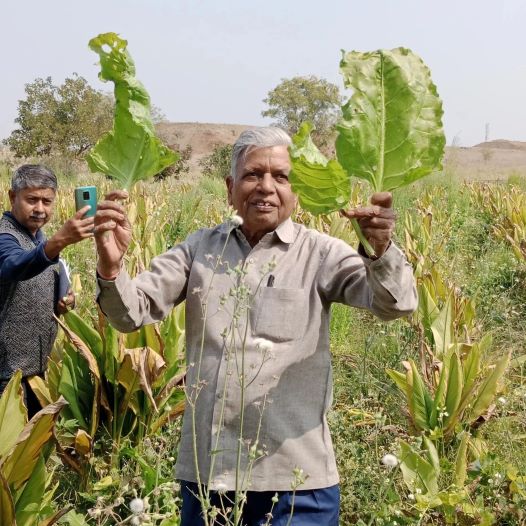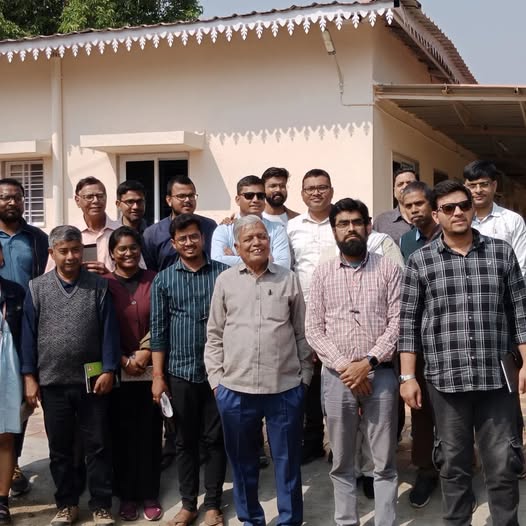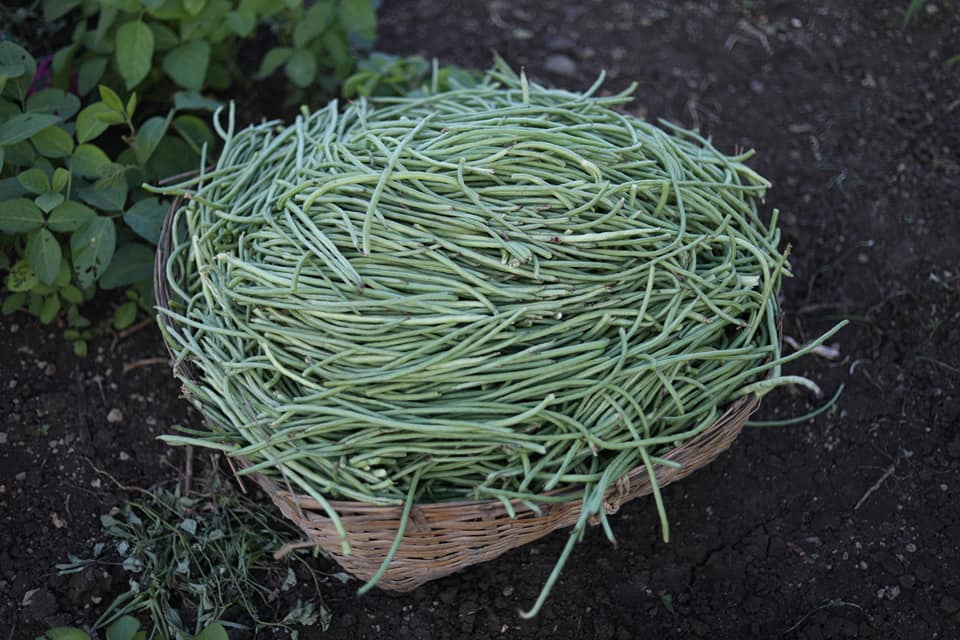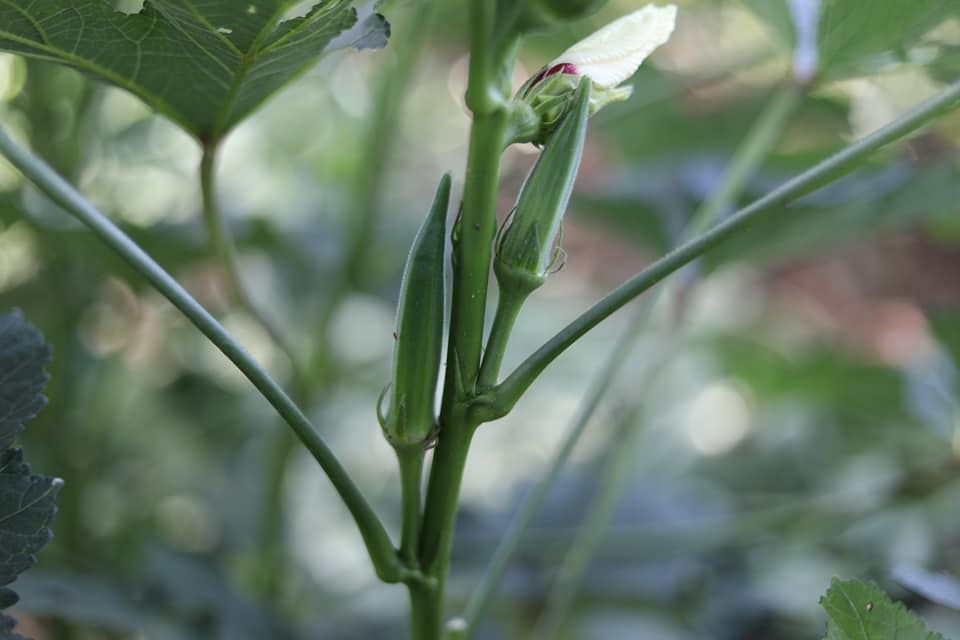Inspiration is not always found under strong limelight. There are people who overcome difficult circumstances, not only to achieve success themselves but to remold the lives of many others through unglamorous but effective initiatives. Here is a story of one such farmer who is inspiring and training farmers in agriculture distress-hit Vidarbha region of Maharashtra, literally bringing them back from the brink of disaster. Subhash Sharma of Yavatmal district has made natural farming technique his unique weapon to ensure personal success and betterment of many other fellow farmers of the region. Interestingly he used his own farm as a live school for the farmers to learn from and experiment. Also, in a very interesting point, Sharma has turned the 40 labourers working in his farm economically self-reliant as he pays them bonus out of profit over their wages. Also he pays more wages to women compared to male labourers as he feels that women work far more in the form of domestic chores. Let’s look at the initiative in details.
Introduction
Vidarbha region is situated in northeastern part of Madhya Pradesh and Yavatmal is one of the districts of Vidarbha region that is known for its cotton farming. Few years ago, the region and the district were in news because of suicides by cotton grower farmers. The major reasons for the suicides were constant failure of crops, mounting loans and drought conditions. But it is amidst such difficult circumstances that Subhash Sharma has charted a new course for the farmers of the region. By adopting natural farming himself and inspiring and training other farmers to do so through live classes in his own farms.
Natural Farming
Subhash Sharma is inspired by Japanese agriculture scientist and philosopher Masanobu Fukuoka. Fukuoka is the pioneer and theorist of natural farming. His book ‘One Straw Revolution’ has been a talking point across the globe. Interestingly, Fukuoka recommends ‘doing nothing’ in his technique. There is to be no cultivation, no use of machines or no spray of chemical fertilizers and pesticides. But an explorer that he is, Subhash Sharma made some changes of his own in the technique. He used bullocks to cultivate his farms rather than using tractors. He does not use any chemical fertilizers or pesticides available in the market and rather prepared organic manure himself.
Experience of Chemical farming
Subhash Sharma shares that he undertook typical chemical farming from 1974 to 1994. At the beginning he got good produce out of the chemical farming method, but the happiness did not last long. By 1986, the productivity of his farm fell drastically. From 12 quintal cotton per acre, he started producing merely 3-4 quintal per acre. The Jowar production, which was earlier at 20 quintal per acre, would not move upwards of 7 quintal per acre. Vegetable production has almost stopped, because the land had become mold infested. Plants of chillies, brinjal would dry up. Overall, the input cost was rising every year and productivity was plunging.
Agriculture and Farming School in Tiwasa
Tiwasa village in Yavatmal district is about 16km from the district headquarters. Subhash Sharma has a 17-acre farm here. He uses 13 acres of this land for farming. Rest of 4 acres is for houses and cattle. Agriculture labourers stay on the land with their families. Sharma himself stays in Yavatmal and makes a day trip here every day. He has purchased the farm few years back and developed it according to his own plan. Now the farm has become a centre of natural farming. Sharma not only does personal farming here, but also trains farmers from across the country. He conducts live farming classes here that are held under a tin-shed sitting on mattresses.
Books are not used for lessons in this live school. Rather the entire farm, crops, insects, birds, plants and trees are media of learning and cattle, animals, birds, water and plants and trees are teachers too. Sharma says that earlier he did chemical farming and now he is engaged in organic farming. The chemical farming caused fertility of the soil to be destroyed, ground water levels to plunge, indigenous seeds to disappear, crop cycles to change and livelihood for agriculture labourers to cease.
Towards Natural/Organic Farming
When the chemical farming started entailing huge costs and use of chemical fertilizers, pesticides and making more efforts did not lead to increase in productivity, Sharma thought of looking at alternatives. It was around that time that he came to know about the farming technique of Japanese agriculture scientist Mosanobu Fukuoka. He read and learnt about the technique and decided to try it out. He then started natural farming. The basic theory is that farming could be done without harming the nature. It is totally environment-friendly way. Sharma says that this method of farming is non-violent, whereas chemical farming is a violent method. Based on his experiences and field lessons, he devised several agriculture techniques. Sharma is basically an experimenting farmer.


Nature Becomes a Teacher
When Sharma started natural farming in 1994, he started understanding the concept of science of creation. He nurtured life forms to develop his farming, whereas chemical farming leads to destruction of life. Use of chemical fertilizers and toxic pesticides adversely impact the soil, water and air. The organisms that make the soil fertile get killed. The birds that fed on the grains and vegetables were also killed. Water turned toxic. Since crop could not grow in tree shadows, trees were chopped down. This meant overall destruction of nature.
In natural farming method, the farming involved all life forms like trees, birds, earthworms and other worms, honey bees, bumble bees and butterflies. It is a completely self-sustaining method with important role of soil, water, air, seeds, crop cycle and manual labour. These are the basics of the natural farming method.
Subhash Sharma says that to understand farming, one should understand the structure of the earth. There is creation on earth. We can understand this with a childhood game lagori (seven stones) wherein stones are balanced one over the other. Nature has also created earth based on mutual coordination and balance. The elements are soil, water and air, trees, plants and other flora, animals, birds and other fauna.
None of these can survive without each other and they supplement each other. But the use of chemical fertilizers destroyed this balance. Due to overuse of chemical fertilizers, soil, water and environment got damaged. Sharma says that for natural farming, a balance of traditional and modern knowledge, proper planning and labour can bring about desired change in farming.
The first step is to improve the health of the soil. For this, rearing indigenous cattle, growing plants and trees are important. Trees will bring in birds who would control the insects and all of them together will give material for organic manure (bio-fertiliser). This will make the soil fertile and good labour on such land will give good results.
Soil is Alive, Not Dead
Before moving forward, it is important to understand the soil structure. Soil is not a dead object, but a living structure. It includes natural chemicals and innumerous organisms and organic material including bacteria, mold, moss etc. These organic matters or micro-organisms grow and survive in the soil and do their work selflessly and this is what keeps the soil fertile.
The life of soil depends on the air passing through it and the amount of micro-organisms and organic matter present. The amount of the organisms and organic matter against depends on proper passage of air through the soil, capacity of absorb and drain water. The microorganisms break down the organic matter (biomass) to produce fertile soil. This fertile layer of the soil forms the topmost layer of the earth and is the best for farming. Lack of proper care of the soil is one of the biggest reasons for decrease of productivity. Subhash Sharma has done the work of improving soil health in an excellent manner.
Method of Preparing Go-Sanjivak Khad
Sharma developed Go-Sanjivak Khad (cattle dung manure) to improve soil health. Giving details of the method he said that 100 litres of water, 30 kg fresh cattle dung, three litres urine of cattle and 500 gms jaggery are mixed in a big utensil or tank. After decomposing for 10 days, liquid manure is ready. This liquid manure is sprayed in the farm to improve amount of microorganisms so that soil could turn fertile and productivity could increase. One acre of farmland will require 10 times of the manure quantity mentioned above. From next year onwards the amount of liquid manure used could be reduced. Sharma says that use of this manure also prevents plant diseases that are normally contracted when chemical fertilizers are used.
Soil Mulching
Soil mulching – where the soil is covered by some plant material to retain the moisture – can lead to increase in beans in pulses crop like tuar. Mulching also leads to increase in soil fertility. Mulching can be done by spreading crop leftovers, hay, grass, leaves, branches and other plant material over the soil to cover it. The soil is protected from open air and sunrays and moisture is retained. Slowly the covering material decomposes and forms bio-fertiliser.
Due to the moist atmosphere in the soil, microorganisms, earthworms, termites and other worms and insects grow and take shelter. Their activity turns the soil grainy, aerated and fertile. Soil is not eroded and water is saved due to availability of moisture. Groundwater table increases and weeds also do not grow.

Making Green Manure
Green manure plays an important role in increasing the fertility of soil. Just like human beings needs all nutrients in food for a healthy body, soil also needs essential nutrients. Green manure can provide the nutrients. To make green manure, it requires 6 kgs of crops of legumes like moong, udad, barbate, arhar, 3 kgs of cereals like bajra, jowar, maize and one kg of oilseeds. These crops are cut about one to one and half months after sowing and then buried in the soil. This creates green manure. The manure includes microorganisms, worms and insects that turn the soil grainy and hollow and improve water infiltration and retention and keep the soil aerated. This adds to the fertility and strength of the soil, which is turns increases productivity of the crop.
200 Trees in the Farm
Planting trees is critical for preventing the negative impacts of climate change as trees have the inherent capacity to control temperatures. Sharma has planted 200 trees in his farm. They include peepal, mango, lemon, neem, blackberry (jamun), jackfruit, umar, gular, bargad, arjun, karonda and others. Honeybees are attracted by the flowers on the plants and help in pollination. Birds of different species also settle on the trees and help in insect control. Insects that eat worms also develop. Trees provide coolness to the atmosphere, which is important for crop growth. Subhash Sharma says that earlier, crops like methi (fenugreek) would not grow properly because they require cooler climate, but now the crop grows well.
The fallen leaves, excreta of birds and insects lead to increase in the amount of microorganisms, worms and other organisms that turn the soil fertile. The aerated soil also leads to increase in groundwater levels. All these components together are leading to increase in productivity of the crops. The trees should be planted in a way that their shadows overlap. They are also source of fresh air. Sharma plans to grow another 200 trees on his farm.
Water Retention in Farm
Sharma says it is important to ensure that the warm from the farm is retained within the farm and proper management is required for this. Industrialisation and chemical-based agriculture has caused temperatures to soar constantly. Apart from atmospheric temperature, the temperature below earth’s surface has also increased and this has turned the soil dry. The rainwater doesn’t percolate inside earth because the microorganisms that made the soil and surface hollow died. This naturally caused the groundwater to deplete and kill several species of flora and fauna. Crops are also adversely affected.
Sharma thus has started sowing crops that require less water. Due to natural organic farming, water is retained along with several microorganisms, worms and insects. They turn the soil hollow and increase percolation and retention of rain and other water.
Also methods like grid locking, micro-locking and contour locking are used to retain water in the farms. Contour locking is used on farms with sloping land. A wide canal has also been dug for the purpose of retaining water and soil. This causes the atmosphere inside soil to be always moist and groundwater resource to increase. The wells have water throughout the year and despite being a drought-prone area, there is no need to get water from outside sources. Water management is one of the important components for increasing crop productivity.
Indigenous Seeds-based Farming
Sharma undertakes indigenous seeds-based farming. He does not purchase any seeds from markets or companies. He has collected the seeds from several places and even developed some of them. Indigenous seeds are favourable to local soil, water and atmosphere and can grow even in inclement conditions. They are season-dependent and even their names are based on the Hindu months. For example, the seeds of cauliflower are named – kuwai (kwar), kartik, aghan, pusi (poush or poos), maghi (magh). Similarly, the names of the seeds of paddy, wheat, brinjal are based on their qualities and identity. Season-dependent seeds have a special quality that even if they are sown late, the crop will ripen at a particular time. They needn’t be purchased from market or companies. The seeds traditionally available with farmers of the region are however becoming extinct. Earlier, all farmers would store their own seeds.

Foodgrains, Fruits, Sand Vegetable Farming
When asked what has he sown this year, Sharma gives a long list of crops – chana, arhar, moong, soybean, turmeric, ginder, chiula phalli, okra, pumpkin, fenugreek, coriander, tomato and banana to name a few. Sharma also chalks out strategy to get good market price of his crops. He doesn’t sell the bananas raw, but rather ripens them with a special technique in a home-built oven. He also sells the petals of amadis. He sows different vegetables that fetch good price in market.
Sharma says that agriculture is a science and not some magic. Earlier, he also did not know much about the science and technology of farming. But slowly, field experience and micro-observation taught him a lot. The focus is on more production at less cost and getting good price from the market. Good organic products, demand in market and selling skills lead to good profit.
The profit is indeed increasing every year for Sharma. His annual turnover is around Rs 25 lakh of which the net profit is almost Rs 13 lakh. He shares that in the drought year of 2008-09, when the production was hit by 25%, but then too he earned profit. Natural farming brings only profit, there is no loss, he says.
Pays Bonus to Labourers
Sharma says that mother earth has given to him much more than he wished for and so he does not keep the entire profit from his farming for himself, but distributes a part of it to the labourers who toil on the farm. Natural farming needs constant physical labour. Currently, 40 men and women (Sharma calls them brothers and sisters) work on his farm. They get work all year round and Sharma pays bonus to them over their wages. He might be the only farmer in the country who not only pays bonus to his workers but also takes them on pilgrimage every year. Till now, he has taken his entire team to Pachmarhi, Vaishno Devi, Somnath and other pilgrimages. This is a unique experience for the workers.
Labourers Are Self-dependent
The labourers working for Sharma have up to Rs 3-4 lakh savings per head in the bank and this fulfills their needs. When the farmers across country are under debt, in such situation, farm labourers becoming self-reliant economically is a notable fact.
Another point of interest is that in these farms of Sharma, women labourers are paid more than the men. When asked the reason, Sharma explains that the women get up way early, do domestic chores, cook and then come to the farms for work, which means that they work far more than the men and thus get paid more.
Concluding Note
To conclude, one can safely say that through this experiment of organic farming, productivity increased, income increased, profit swelled and employment was generated. Not only the farm labourers here are ensured of work round the year, but they also get bonus. Thus they have become economically self-reliant and have enough savings in banks.
The input cost for farming has reduced. This method of farming is labour-intensive rather than capital-intensive. Also soil and water is conserved, something which is very important in current situation. The important of natural/organic farming increases manifold in the current era of climate change and global warming. Tree plantation has helped in temperature control here. Conservation and preservation of indigenous seeds has been done. Overall, it is a sustainable, self-dependent and environment-friendly mode of farming. Self-dependent in the sense that the seeds are from home, Go-Sanjivak manure from home, techniques devised by self and dependent on manual labour.
This example tells us that if we want to increase crop productivity, it is important to conserve soil and water. Natural farming also develops a sense of social responsibility that human beings are not owners of natural resources but their conservers who have to keep the resources safe for future generations. Natural farming not only preserves and conserves soil, water, seeds and environment, but also adds to them.
This mode of farming is also a complete lifestyle in itself. When we take up natural farming in the place of destructive farming, our food habits also change, social and life values also change. This farming teaches us to fill the stomach of human beings while safeguarding all other life-forms.
